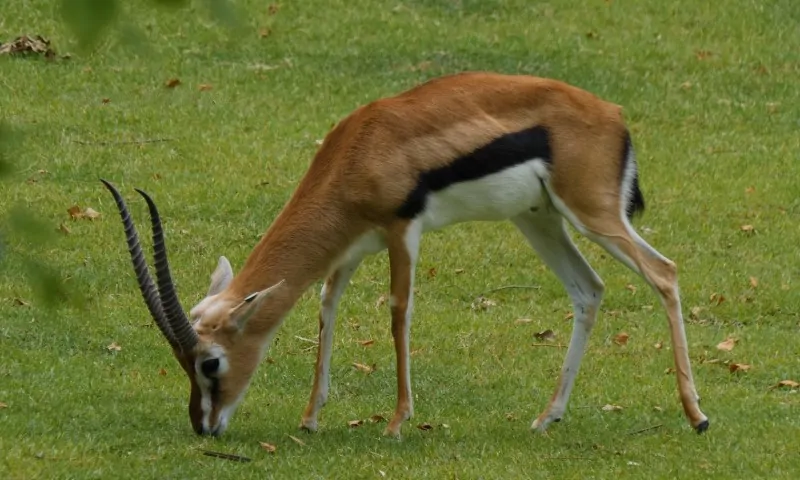When thinking about deserts, what usually comes to mind is endless stretches of sand, intense heat, and a landscape that seems hostile to life. However, deserts are far from barren wastelands.
They are home to some of the most bizarre and fascinating plants on Earth, each uniquely adapted to thrive in these harsh environments.
Let’s take a closer look at some of the most unusual desert plants that have found ways to survive, and even thrive, in such extreme conditions.
Table of Contents
Toggle1. Welwitschia Mirabilis (The Living Fossil)
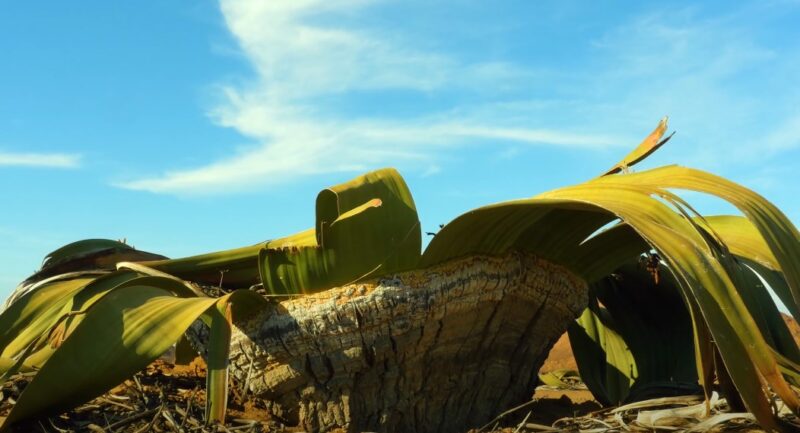
Imagine a plant that’s been around since the time of the dinosaurs and can live for over a thousand years. That’s Welwitschia mirabilis for you. Found in the Namib Desert, this plant has only two leaves, but don’t let that fool you—it’s one tough survivor.
What’s truly remarkable is its ability to absorb water from fog, making it perfectly suited to one of the driest places on the planet.
Key Features
- Longevity: Welwitschia mirabilis can live for over a thousand years, making it a true “living fossil.”
- Unique Leaf Structure: The plant only ever produces two leaves, which grow continuously throughout its life, reaching lengths of up to 13 feet.
- Desert Adaptation: Endemic to the Namib Desert, it is highly adapted to survive in extreme arid conditions.
2. Boojum Tree (Fouquieria columnaris)
The Boojum Tree is as strange as its name suggests. Native to the Baja California peninsula and the Sonoran Desert, it looks like something out of a Dr. Seuss book.
This tree resembles a giant, upside-down carrot sticking out of the ground, with a slender trunk that can reach up to 70 feet high. Its branches are sparse, and during droughts, the tree sheds its leaves to conserve moisture, making it appear even more unusual.
Key Features
- Unique Appearance: The Boojum Tree has a single, tapering trunk resembling a tall candle, which can reach heights of up to 70 feet.
- Desert Adaptation: It is a succulent plant with soft, easily bruised wood, adapted to arid environments in Baja California and Sonora, Mexico.
- Flowering: The tree produces creamy yellow tubular flowers in mid to late summer, attracting pollinators like hummingbirds.
3. Hydnora Africana (The Parasitic Horror)
If there’s a plant that could easily be cast in a horror movie, it’s Hydnora africana. This parasitic plant, found in Southern Africa, lives most of its life underground, attached to the roots of other plants.
It only surfaces to bloom, revealing a fleshy, mouth-like flower that looks like something straight out of a nightmare. To attract pollinators, it emits a foul odor that mimics the smell of feces, drawing in dung beetles.
Key Features
- Parasitic Nature: Hydnora africana is a fully parasitic plant with no roots, leaves, or chlorophyll, living entirely underground except for its fleshy flower.
- Unique Flower: The plant produces a large, fleshy, underground flower that is typically brown on the outside and bright orange to salmon on the inside.
- Host Dependency: It is an obligate parasite, completely dependent on its host plant, usually from the Euphorbia genus, for nutrients.
4. Lithops (The Living Stones)
Lithops, or “Living Stones,” are masters of disguise. These small succulents are native to Southern Africa and have evolved to look just like the pebbles and stones in their environment.
This camouflage helps them avoid being eaten by animals in search of water. Each plant consists of two fused leaves that form a stone-like appearance, with a small fissure between them where a daisy-like flower blooms.
Key Features
- Camouflage: Lithops blend in with their surroundings by mimicking the appearance of stones or pebbles, making them difficult to spot in their native habitat.
- Small Size: They grow slowly and typically reach only 1-4 inches in diameter, making them compact and low-growing.
- Unique Flowering: Lithops produce delicate, daisy-like flowers that emerge from the center of their paired leaves.
5. Adenium Obesum (The Desert Rose)
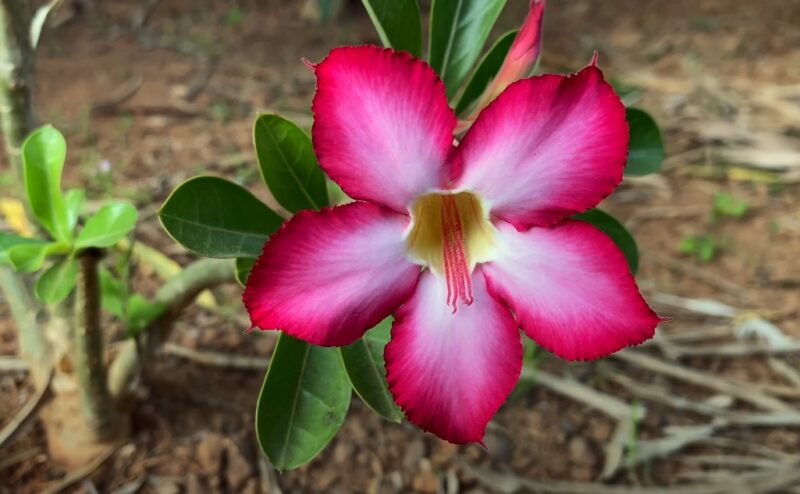
Adenium obesum, also known as the Desert Rose, is a plant that combines beauty with resilience.
Native to the Sahel regions of Africa and the Arabian Peninsula, it’s easily recognizable by its swollen, bulbous trunk, which stores water, and its vibrant, tubular flowers that can range from pink to red to white.
Its striking flowers and ability to thrive in poor, sandy soils make it a true standout among desert flora.
Key Features
- Thick, Swollen Stem: The Desert Rose has a thick, swollen trunk that stores water, helping it survive in arid conditions.
- Showy, Trumpet-Shaped Flowers: It produces vibrant flowers in shades of pink, white, purple, and red, which are the main attraction of the plant.
- Succulent Shrub: The plant has shiny, dark green leaves and is often likened to a bonsai due to its shape and growth habit.
6. Ocotillo (Fouquieria Splendens)
Ocotillo, also known as the Flaming Sword, is a plant that knows how to make an entrance. Found in the southwestern United States and northern Mexico, Ocotillo consists of long, spiny stems that grow up to 20 feet tall.
During dry spells, the stems appear dead, but after a rain, they quickly sprout small green leaves and bright red flowers. This rapid transformation is an adaptation to the unpredictable desert rainfall.
Key Features
- Spiny Stems: Ocotillo has long, cane-like, unbranched spiny stems that grow vertically, creating a vase-shaped appearance.
- Bright Red Flowers: It produces clusters of bright red flowers, especially in spring, attracting pollinators like hummingbirds.
- Drought Adaptation: Ocotillo is well-adapted to desert conditions, blooming sporadically in response to rainfall.
7. Saguaro Cactus (Carnegiea Gigantea)
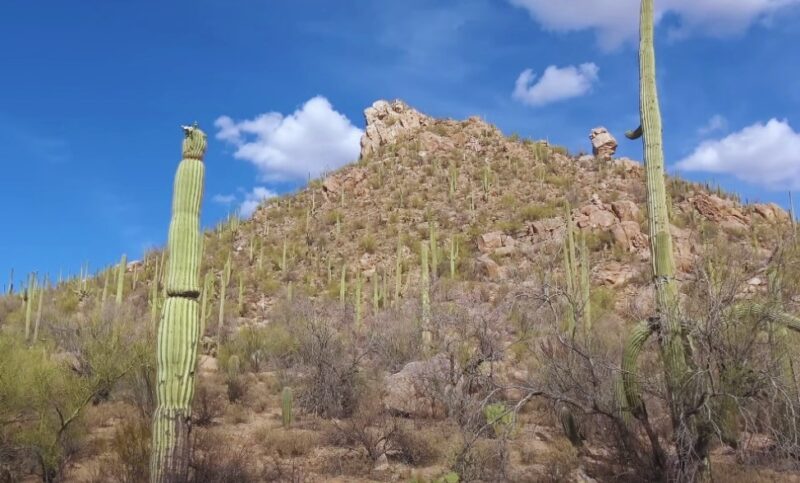
The Saguaro Cactus is an iconic symbol of the American Southwest. Towering over 50 feet tall, it’s one of the largest cacti in the world and can live for more than 150 years.
The Saguaro’s pleated structure allows it to expand and store vast amounts of water during the rainy season, and its thick skin helps minimize water loss.
From birds to bats, many species rely on the Saguaro for food and shelter, making it a keystone species in its habitat.
Key Features
- Size and Weight: Saguaro cacti can grow up to 50 feet tall and weigh up to 6 tons when fully hydrated.
- Habitat: Native to the Sonoran Desert, they are exclusive to this region and provide essential food and shelter for desert animals.
- Adaptations: Saguaros have accordion-like ribs that allow them to store large amounts of water, essential for survival in the desert environment.
8. Baobab Tree (Adansonia)
The Baobab tree, often referred to as the “Tree of Life,” is a massive, ancient tree native to Madagascar, Africa, and Australia. It can live for thousands of years and grow to incredible sizes, with trunks up to 30 feet in diameter.
The Baobab is a master at water storage, holding large amounts of water in its trunk to survive the dry season. Its fruit, known as monkey bread, is packed with nutrients and has been a vital food source for both animals and humans for centuries.
Key Features
- Water Storage: The baobab tree has a massive, water-storing trunk that helps it survive in arid environments.
- Ecosystem Support: Known as the “Tree of Life,” it provides shelter, food, and water for various species and helps maintain soil conditions.
- Longevity and Size: These trees can grow up to 100 feet tall with a significant circumference, often living for thousands of years.
9. Peyote (Lophophora Williamsii)

Peyote is more than just a plant; it’s a spiritual symbol for many indigenous peoples of Mexico and the southwestern United States. This small, spineless cactus is best known for its psychoactive properties, containing mescaline, a potent hallucinogen.
Despite its small size, Peyote’s cultural significance and slow growth make it one of the most intriguing plants found in desert regions.
Key Features
- Hallucinogenic Cactus: Peyote is a small, spineless cactus known for its psychoactive properties, specifically containing mescaline.
- Habitat: It primarily grows in limestone soils in the Chihuahuan Desert.
- Appearance: The cactus is small, round, and typically has a bluish-green color with tufts of white hair.
10. Queen of the Night (Peniocereus Greggii)
The Queen of the Night is a cactus with a flair for the dramatic. Native to the Sonoran Desert, this unassuming plant blends into the landscape most of the year. However, on one special night each summer, it produces large, fragrant, white flowers that bloom for just a few hours.
This rare event, often referred to as “The Night of the Queen,” is a spectacle that attracts pollinators like moths and bats.
Key Features
- Night-blooming: The Queen of the Night blooms only once a year, usually at night, with large, fragrant white flowers that wilt before sunrise.
- Camouflaged: The cactus blends well with its surroundings, often hidden under other desert plants like creosote bushes and mesquite.
- Inconspicuous appearance: The plant has thin, gray stems that resemble dead twigs, making it difficult to spot when not in bloom.
11. Doll’s Eye (Actaea Pachypoda)
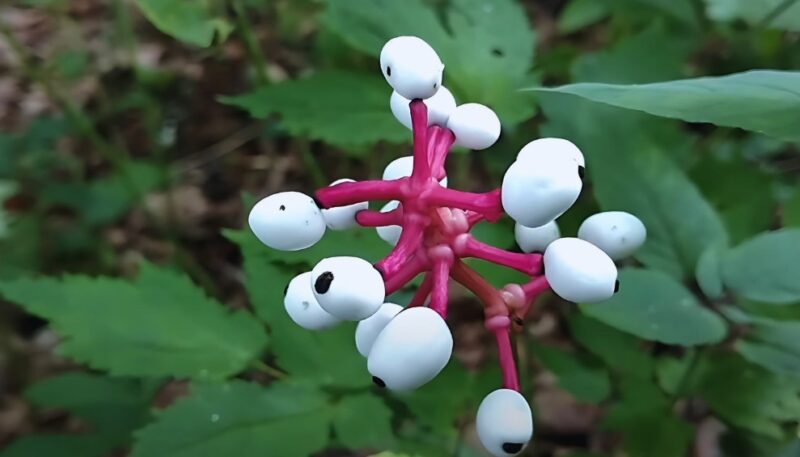
Doll’s Eye is a plant that might seem out of place on this list since it’s typically found in forests, but it occasionally makes its way into arid regions. Known for its eerie, white berries with black dots that resemble doll’s eyes, this plant is as dangerous as it is strange.
The berries are highly toxic and can be deadly if consumed. Doll’s Eye’s unusual appearance and its potential for harm make it a plant that both fascinates and warns those who encounter it.
Key Features
- Distinctive white berries: The plant produces white berries with a black spot, resembling a doll’s eye, hence the name.
- Attractive foliage: It has deeply ribbed, lush green foliage that adds texture to the garden.
- Small white flowers: The plant blooms in May and June with small white flowers in frothy clusters.
12. Joshua Tree (Yucca Brevifolia)
The Joshua Tree is as much a symbol of the Mojave Desert as the Saguaro is of the Sonoran. Its twisted, spiky branches stretch toward the sky, giving it a unique silhouette against the desert backdrop.
Named by Mormon settlers who thought its branches looked like the biblical Joshua praying, this tree is incredibly resilient. It can live for hundreds of years and has a deep root system that taps into underground water sources.
Key Features
- Unique Appearance: Joshua trees have twisted branches with clusters of spiky, gray-green leaves, creating a distinctive silhouette.
- Habitat: Native to the arid regions of the Southwestern United States, specifically in the Mojave Desert.
- Growth Characteristics: These slow-growing trees can reach heights of 3 to 9 feet before branching, with a trunk diameter of 1 to 3 feet.
Summary
Desert plants are nothing short of extraordinary. From the ancient and enduring Welwitschia to the short-lived but stunning Queen of the Night, these plants have developed remarkable adaptations that allow them to survive, and even flourish, in environments that would be inhospitable to most other life forms.
If you ever find yourself wandering through a desert, take a moment to appreciate the strange and wonderful plants that call it home. They are living proof that life, in all its forms, finds a way to thrive, even in the most unlikely of places.
Related Posts:
- Top 10 Most Dangerous Desert Animals You Should Avoid
- Why Camels Eating Snakes Might Not Be as Strange as It Seems
- What Makes Welwitschia One of the World’s Most…
- Top 12 Amazing Desert Landscapes In The World
- Top 10 Nocturnal Animals of the African Deserts
- What Do Spider Eggs Look Like and Where Can You Find Them?




